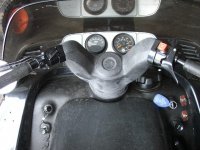Actually, the RS is nowhere near a sportbike seating position. With only 6 degrees of torso lean, it's more accurate to call it an aggressive standard (if anything, the aggressive part comes at the knees-- that's the biggest difference between the RS and RT in my book, your knees are tucked behind on the RS whereas they're practically straight down on the RT).
Great site if you've never visited-- compare the RS to the RT, or the RS to other standards/touring bikes-- or actual sport bikes (even a "standard-like" sport bike like the Ninja 250 is raked far more aggressively than the RS... forget something like a Gixxer).
http://cycle-ergo.com/
Personally, while I agree that risers make a big difference on the RS, good footboards/floorboards contribute just as much if not more benefit. Plant your feet and knees in the right spot with the right leverage and you can take a lot of strain off your arms and back while riding.
Yeah, you have to add the risers, floorboards, and probably even a new seat to make the RS a touring machine, but the plus side is that you really can make the RS your own ergonomically (on the RT, you can modify seat and your feet, but no risers are available, so if the grips aren't perfect for you out of the box, your options are limited).
Anyway, this subject is important to me because I know that at first I wasn't at all interested in the Spyder RS BECAUSE I wasn't at all interested in sport bike ergonomics, and the Spyder RS *looks* like it has a sport bike's ergonomics.
It wasn't until I actually was able to sit on one at a dealer that I discovered that, hey, this seating position is nothing like a sport bike's, it's actually quite comfortable, and with modifications, it's easily tourable.
To be honest, the RS probably could stand to be MORE like a sportbike to differentiate it more from the RT. Meaning, if the RS had a more aggressive seating position, it'd probably be more physically comfortable out of the box then the admittedly bizarre compromise between torso and knee angle on the bike.
Trouble is, you really can't get a good sportbike position on the Spyder given the width of the bike (on a sportbike you can tuck your knees in and grip against the tank, you don't really have that option on the wider Spyder, best you can do is more of a firm "press). Likewise, there's no real need to ride in that position on a three-wheeled machine-- sure, bending forward *feels* fun and sporty, but with three un-leaning wheels on the ground there's no need for the type of body english one uses on a sportbike, you use a different set of muscles to shift on the Spyder. (If anything, I discovered that after I put my floorboards on and was able to *lower* my feet on the bike from the height of the pegs, my control over the Spyder increased versus riding it on the pegs-- the precise opposite of two-wheels IME).
P.S. If a leaning Spyder were to ever come out, it'll be interesting to see how the ergonomics change for that bike. I believe that simply adding leaning wheels to the Spyder RS's current ergonomics would be a mistake-- either they need to make you lean your torso forward *more*, or they need to move your knees forward to make it more like the RT.
pps: :roflblack:

